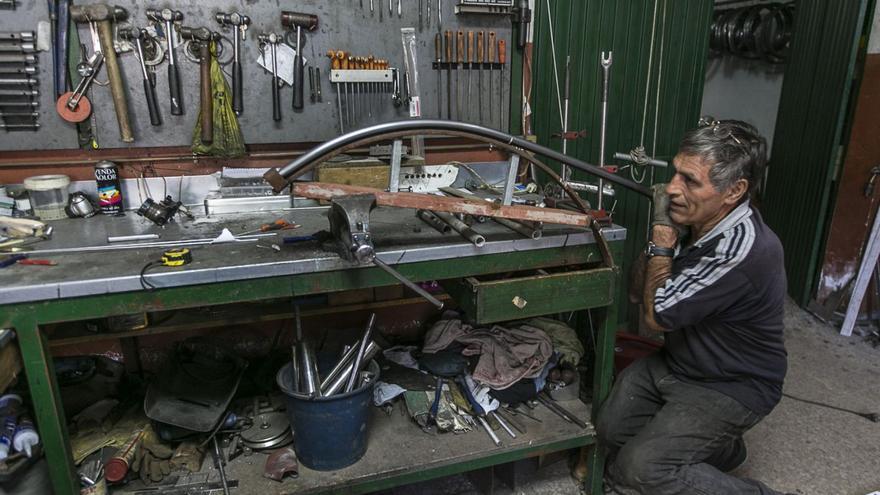
“I used to get sick before I became self-employed, but not anymore; the immune system of the self-employed hardens. Grace is part of the 93,041 self-employed workers in the Canary Islands. He runs a cafeteria in Santa Cruz de Tenerife in which her mother, Esther, is the only employee. “The contribution is excessive,” laments Daniel, a self-employed person who offers remote services for several multinationals in the sector of ICT (Information and Communication Technologies). One and the other carry out activities that have little to do with each other, but for the Public Administration both are the same: self-employed. A category that, in reality, “only makes sense for the purposes of listing on the Social Security“, Explain Manuel Garcia Bernardezresearcher at Sevilla University that has x-rayed a group of such great heterogeneity that it ruins the efforts to establish a common regime. First of all, because there is a first great dichotomy: that of the self-employed person with employees –employees themselves, not those of those who, like Grace, have the help of their partner or a relative because they have no other choice– and that of the self-employed person without employees. While the former resembles an entrepreneur in terms of income, the latter is closer to a day laborer or sharecropper in the agricultural sector. And it happens that the latter, those self-employed workers without resources to hire anyone, are the vast majority. In the Islands, 76.3%. In other words, three out of four self-employed workers in the Archipelago have more in common with a farm worker than with a businessman.
“In Spain, being self-employed without employees is hard,” summarizes Professor García Bernárdez, who has been researching together with the sociologist Ildefonso Marquis Perales to unravel the reality of this group. The first conclusion – “sometimes the obvious is so obvious that it ceases to be so”, he specifies – is that there is no group of self-employed or self-employed, but that within the definition there are very different groups. «It is a space as large and with as much heterogeneity as society as a whole»; That is why any attempt to reform taxation and the contribution system for self-employed workers requires, underlines the expert, to categorize them. The last attempt was that of the minister Jose Luis Escriva, which raised blisters with its proposal for a new listing framework. The fact is that Escrivá’s idea, regardless of its greater or lesser wisdom, once again speaks of the self-employed, thus, in general, and although the need for a tax reform and social contributions is “obvious”, “say that this is necessary for the self-employed is as much as saying nothing, ”explains the researcher from the University of Seville. “You have to establish categories, because you are trying to legislate at once for sectors or activities that are very different from each other,” he adds. Grace works in restoration; Daniel teleworks in the field of ICT; there are self-employed by inheritance; there are for imposition; there are those who enter as a successful entrepreneur; and there are many others, the most, who barely make ends meet. Too many profiles to put them in the same bag.
the teacher of the Alma mater Seville exposes, after analyzing the income of the self-employed and employees from the European survey on wages and living conditionsthat the first conclusion is clear: the self-employed worker pure, the one that does not have personnel in charge, is at the bottom of the employed population in terms of income. In fact he is only above the agricultural laborer. And yet, in terms of the tax burden and Social Security contributions, it is the second most punished. In other words: the self-employed person is treated in tax matters as an entrepreneur when his income is that of an unskilled worker. In short, Daniel is right: “I don’t know whether or not we have to pay taxes on real income, but it is evident that we pay taxes in amounts well above what we earn.” “Spain does not encourage the self-employed, and, in addition, there are such a number of requirements that you have to think about it a lot before undertaking,” says Grace.
The problem, however, is neither the tax burden nor the contributions. García Bernárdez points out that if the fiscal pressure is high, it is not because the burden borne by the Spanish and Canarian self-employed is above the average of neighboring countries, but rather because income is below and even far below below average. For this reason, tax pressure is not an obstacle for the self-employed with employees, especially for those with ten or more dependents. These suffer a tax burden in the European average but have an income that is nothing like that of the self-employed without employees. “In income these are in third position, they rise a lot with respect to the average”, points out the professor. “That is why the category of self-employed is useless; because if on one side of the axis you put the employers and on the other side, the unskilled workers, the self-employed with more than ten employees will go to the side of the employers and those who do not have, to the unskilled” .
Of the 93,041 self-employed islanders, 70,997 are thus similar to unqualified personnel. And among the 22,044 with employees, those with more than ten are a minority.















